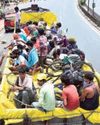ISRO crosses yet another milestone with the successful launch and return of a winged Reusable Launch Vehicle in a scaled-down configuration that flew in a hypersonic regime.

Bringing down significantly the cost of access to space is a primary goal of space programmes around the world today. What this means, for example, is reducing the cost/kg of payload delivered when a launch vehicle is used to put a satellite into orbit. There are, of course, different options by which one can think of reducing this cost from the following basic considerations. Typically, the on-board propellant accounts for about 85 per cent of the mass and the rest is structural hardware. The payload fraction itself is quite small, ranging from 0.4 per cent to 1 per cent of the total mass depending upon the mission and the efficiency of the system. In terms of cost, however, the hardware accounts for about 80 per cent of the launch cost. The cost of the fuel itself is negligible.
Conceptually, therefore, there are three strategies to reduce the cost/kg of payload mass: (i) improve the payload fraction by adopting newer technologies and improving the overall efficiency of the system, including increasing the thrust of the vehicle by more efficient liquid fuel engines, such as semi-cryogenic and cryogenic engines; (ii) recover the hardware and reuse for multiple launches; and (iii) reduce the initial propellant loading by adopting newer combustion modes such as air breathing ramjet / scramjet propulsions, and any suitable combination thereof depending on the mission at hand.
Denne historien er fra June 24, 2016-utgaven av FRONTLINE.
Start din 7-dagers gratis prøveperiode på Magzter GOLD for å få tilgang til tusenvis av utvalgte premiumhistorier og 9000+ magasiner og aviser.
Allerede abonnent ? Logg på
Denne historien er fra June 24, 2016-utgaven av FRONTLINE.
Start din 7-dagers gratis prøveperiode på Magzter GOLD for å få tilgang til tusenvis av utvalgte premiumhistorier og 9000+ magasiner og aviser.
Allerede abonnent? Logg på

How Not To Handle An Epidemic
The lockdowns were meant to buy time to put in place appropriate health measures and contain the coronavirus’ spread, but they have failed to achieve the objective and heaped immense misery on the marginalised sections of society. India is still in the exponential phase of the COVID-19 infection and community transmission is a reality that the government refuses to accept.

Tragedy on foot
As the COVID-19-induced lockdown cuts the ground beneath their feet in Tamil Nadu, thousands of migrant workers are trudging along the highway to the relative safety of their upcountry homes.

Sarpanchs as game changers
Odisha manages to keep COVID-19 well under control because of the strong participation of panchayati raj institutions and the community at the grass-roots level under the leadership of Chief Minister Naveen Patnaik.

Scapegoating China
As the COVID-19 death rate spikes and the economy tanks in the United States, Donald Trump and his advisers target China and the World Health Organisation with an eye to winning the forthcoming presidential election.

New worries
Kerala’s measured approach to the pandemic and lockdown has yielded results. But it still has to grapple with their huge economic impact on its economy, which it feels the Centre’s special financial relief package does little to alleviate.
No love lost for labour
Taking advantage of the lockdown and the inability of workers to organise protests, many State governments introduce sweeping changes to labour laws to the detriment of workers on the pretext of reviving production and boosting the economy.

Capital's Malthusian moment
In a world that needs substantial reorienting of production and distribution, Indian capital is resorting to a militant form of moribund neoliberalism to overcome its current crisis. In this pursuit of profit, it is ready and willing to throw into mortal peril millions whom it adjudicates as not worth their means—an admixture of social Darwinism born of capital’s avarice and brutalism spawned by Hindutva. .

Understanding migration
When governments and their plans are found to be blatantly wanting in addressing reverse migration, exercises such as the Ekta Parishad’s survey of migrant workers throughout India can be useful to work out creative long-lasting solutions.

Waiting for Jabalpur moment
The Supreme Court’s role in ensuring executive accountability during the ongoing lockdown leaves much to be desired. Standing in shining contrast is the record of some High Courts.

An empty package
The Modi regime, which has been unable to control the COVID-19 infection, restore economic activity and provide relief to millions exposed to starvation, trains its sights on Indian democracy, making use of the panic generated by fear and a lockdown that forecloses paths of resistance.